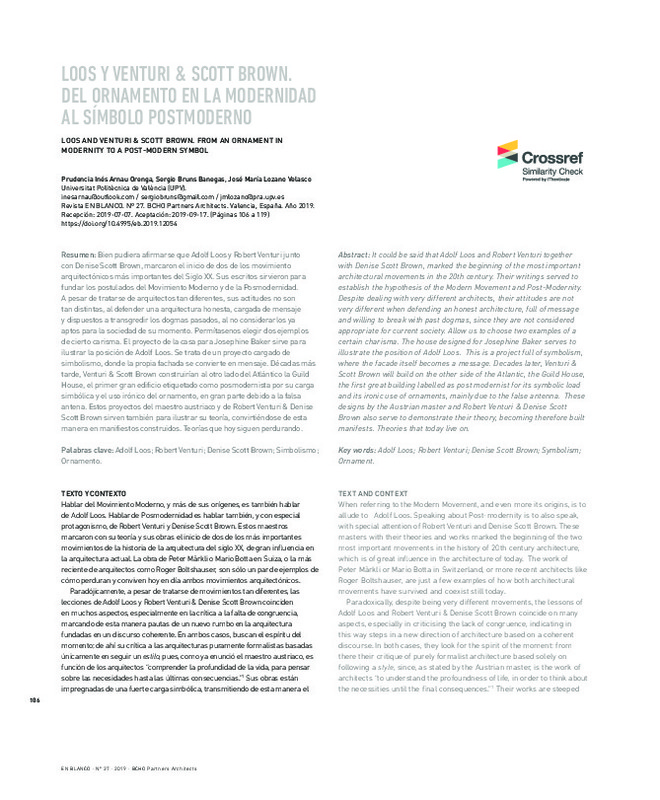JavaScript is disabled for your browser. Some features of this site may not work without it.
Buscar en RiuNet
Listar
Mi cuenta
Estadísticas
Ayuda RiuNet
Admin. UPV
Loos y Venturi & Scott Brown. Del ornamento en la modernidadal símbolo postmoderno
Mostrar el registro sencillo del ítem
Ficheros en el ítem
| dc.contributor.author | Arnau Orenga, Prudencia Inés
|
es_ES |
| dc.contributor.author | Bruns Banegas, Sergio
|
es_ES |
| dc.contributor.author | Lozano Velasco, José María
|
es_ES |
| dc.coverage.spatial | east=-75.15075289999999; north=39.9617666; name=711-39 Spring Garden St, Philadelphia, PA 19123, Estats Units d'Amèrica | es_ES |
| dc.date.accessioned | 2019-11-08T10:50:55Z | |
| dc.date.available | 2019-11-08T10:50:55Z | |
| dc.date.issued | 2019-10-30 | |
| dc.identifier.issn | 1888-5616 | |
| dc.identifier.uri | http://hdl.handle.net/10251/130518 | |
| dc.description.abstract | [ES] Bien pudiera afirmarse que Adolf Loos y Robert Venturi junto con Denise Scott Brown, marcaron el inicio de dos de los movimiento arquitectónicos más importantes del Siglo XX. Sus escritos sirvieron para fundar los postulados del Movimiento Moderno y de la Posmodernidad. A pesar de tratarse de arquitectos tan diferentes, sus actitudes no son tan distintas, al defender una arquitectura honesta, cargada de mensaje y dispuestos a transgredir los dogmas pasados, al no considerarlos ya aptos para la sociedad de su momento. Permítasenos elegir dos ejemplos de cierto carisma. El proyecto de la casa para Josephine Baker sirve para ilustrar la posición de Adolf Loos. Se trata de un proyecto cargado de simbolismo, donde la propia fachada se convierte en mensaje. Décadas más tarde, Venturi & Scott Brown construirían al otro lado del Atlántico la Guild House, el primer gran edificio etiquetado como posmodernista por su carga simbólica y el uso irónico del ornamento, en gran parte debido a la falsa antena. Estos proyectos del maestro austriaco y de Robert Venturi & Denise Scott Brown sirven también para ilustrar su teoría, convirtiéndose de esta manera en manifiestos construidos. Teorías que hoy siguen perdurando. | es_ES |
| dc.description.abstract | [EN] It could be said that Adolf Loos and Robert Venturi together with Denise Scott Brown, marked the beginning of the most important architectural movements in the 20th century. Their writings served to establish the hypothesis of the Modern Movement and Post-Modernity. Despite dealing with very different architects, their attitudes are not very different when defending an honest architecture, full of message and willing to break with past dogmas, since they are not considered appropriate for current society. Allow us to choose two examples of a certain charisma. The house designed for Josephine Baker serves to illustrate the position of Adolf Loos. This is a project full of symbolism, where the facade itself becomes a message. Decades later, Venturi & Scott Brown will build on the other side of the Atlantic, the Guild House, the first great building labelled as post modernist for its symbolic load and its ironic use of ornaments, mainly due to the false antenna. These designs by the Austrian master and Robert Venturi & Denise Scott Brown also serve to demonstrate their theory, becoming therefore built manifests. Theories that today live on. | es_ES |
| dc.language | Español | es_ES |
| dc.language | Inglés | es_ES |
| dc.publisher | Universitat Politècnica de València | |
| dc.relation.ispartof | EN BLANCO. Revista de Arquitectura | |
| dc.rights | Reconocimiento - No comercial (by-nc) | es_ES |
| dc.subject | Adolf Loos | es_ES |
| dc.subject | Robert Venturi | es_ES |
| dc.subject | Denise Scott Brown | es_ES |
| dc.subject | Symbolism | es_ES |
| dc.subject | Ornament | es_ES |
| dc.subject | Simbolismo | es_ES |
| dc.subject | Ornamento | es_ES |
| dc.title | Loos y Venturi & Scott Brown. Del ornamento en la modernidadal símbolo postmoderno | es_ES |
| dc.title.alternative | Loos and Venturi & Scott Brown. From an ornament in modernity to a post-modern symbol | es_ES |
| dc.type | Artículo | es_ES |
| dc.date.updated | 2019-11-08T09:05:00Z | |
| dc.identifier.doi | 10.4995/eb.2019.12054 | |
| dc.rights.accessRights | Abierto | es_ES |
| dc.contributor.affiliation | Universitat Politècnica de València. Departamento de Proyectos Arquitectónicos - Departament de Projectes Arquitectònics | es_ES |
| dc.description.bibliographicCitation | Arnau Orenga, PI.; Bruns Banegas, S.; Lozano Velasco, JM. (2019). Loos y Venturi & Scott Brown. Del ornamento en la modernidadal símbolo postmoderno. EN BLANCO. Revista de Arquitectura. 11(27):106-119. https://doi.org/10.4995/eb.2019.12054 | es_ES |
| dc.description.accrualMethod | SWORD | es_ES |
| dc.relation.publisherversion | https://doi.org/10.4995/eb.2019.12054 | es_ES |
| dc.description.upvformatpinicio | 106 | es_ES |
| dc.description.upvformatpfin | 119 | es_ES |
| dc.type.version | info:eu-repo/semantics/publishedVersion | es_ES |
| dc.description.volume | 11 | |
| dc.description.issue | 27 | |
| dc.identifier.eissn | 2445-1215 |








